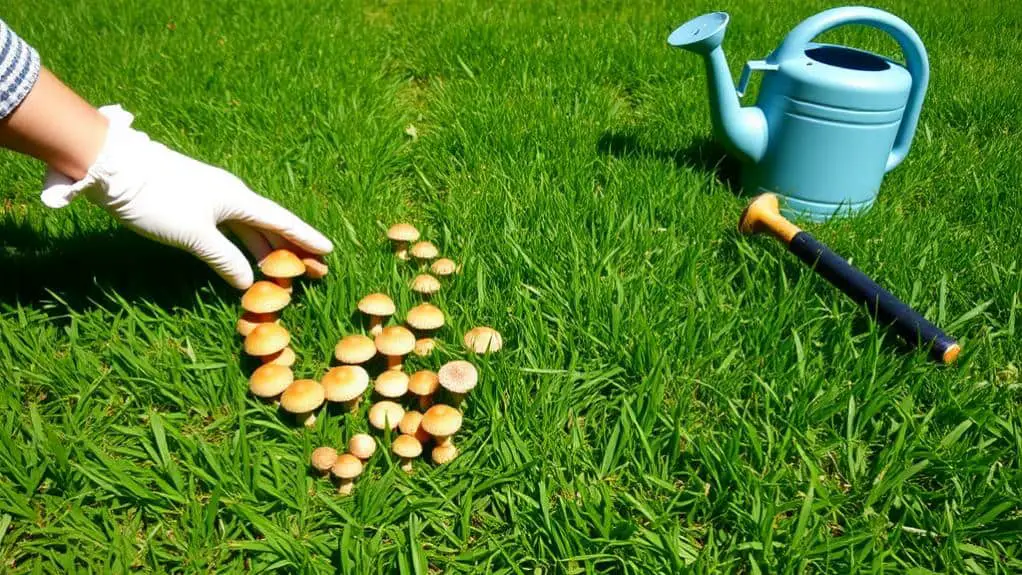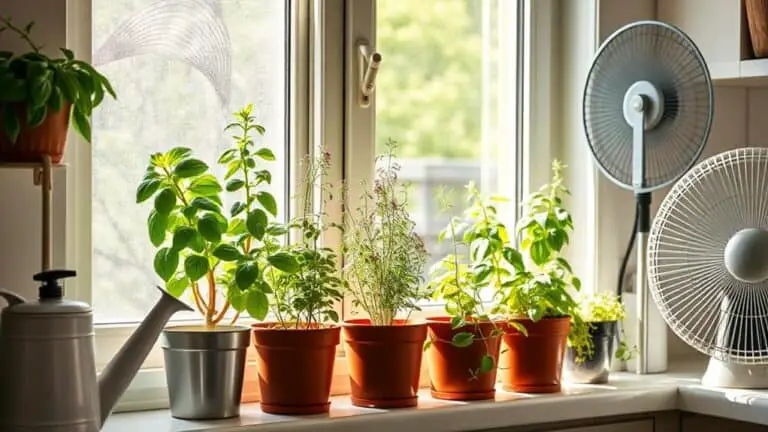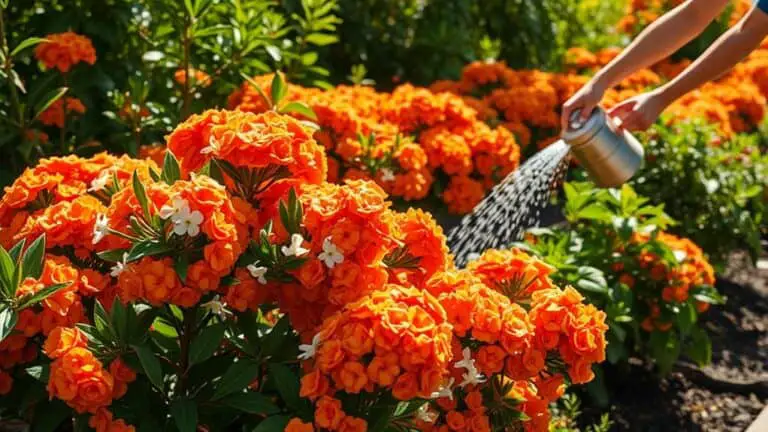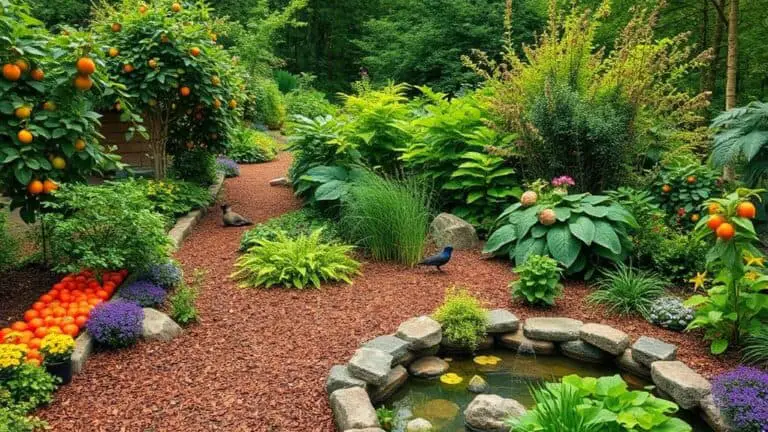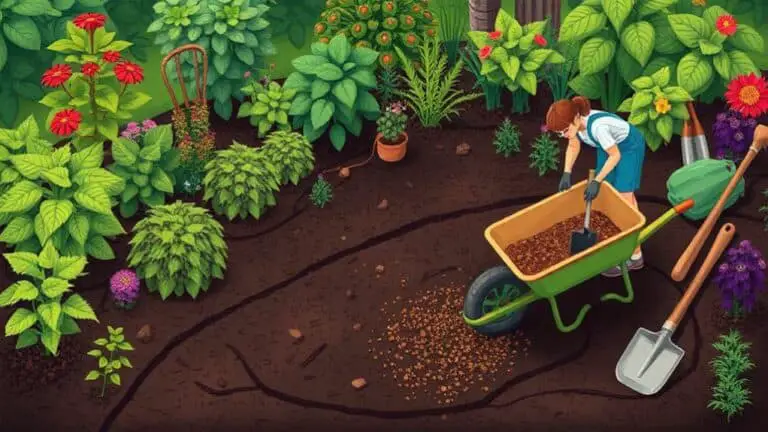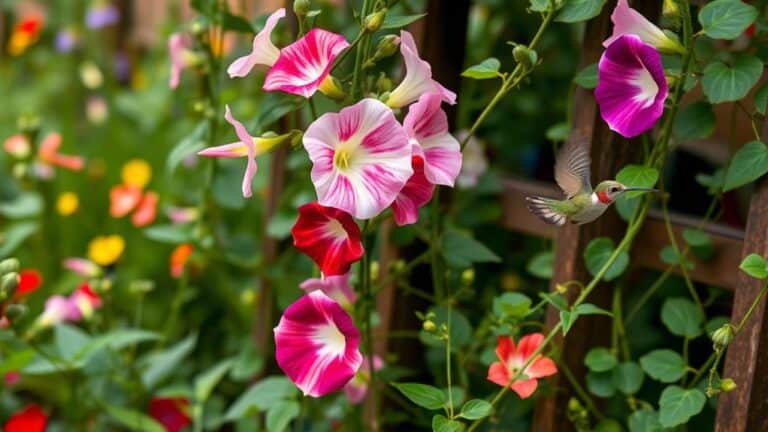How To Get Rid Of Mushrooms In Yard
I've noticed mushrooms popping up in my yard lately, and I'm sure you've dealt with the same pesky problem. It's not just about aesthetics; some mushrooms can be harmful to pets and kids. To tackle this issue effectively, we need to understand the root causes and employ a few practical strategies. From removing decaying organic matter to reflecting on natural fungicides, there are several steps we can take. However, there's one essential aspect that often gets overlooked, making all the difference in keeping these fungi at bay. Let's explore what that is.
Causes of Mushroom Growth
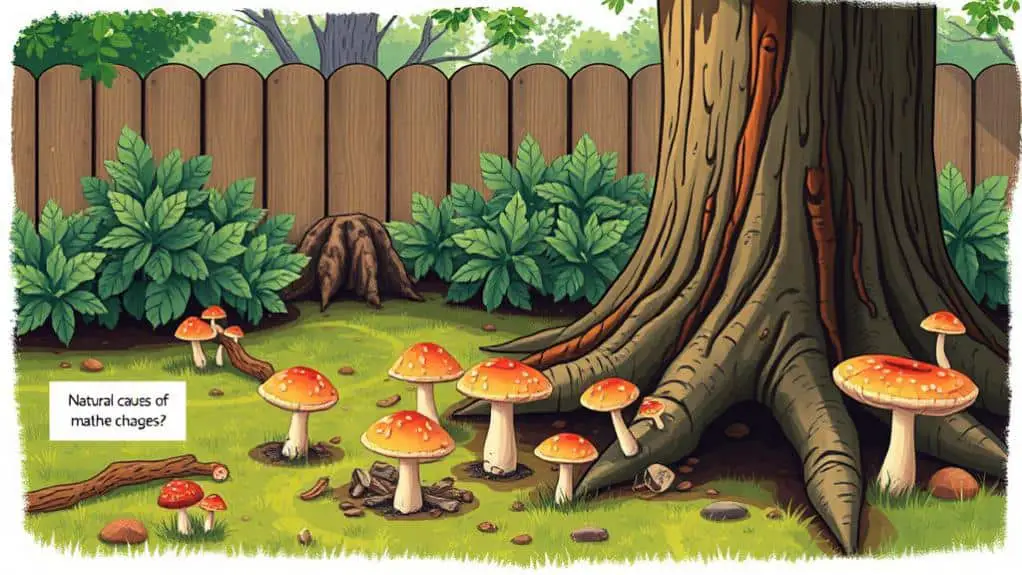
Mushrooms in your yard can be a frustrating sight, often sprouting due to the presence of decaying organic matter like fallen leaves, grass clippings, and tree stumps.
These fungi thrive when conditions are favorable, which means plenty of moisture and shade. If your yard has poor drainage, standing water can easily form, creating a perfect environment for mushrooms.
Shady spots, especially under trees or near structures, keep the ground damp and dark, promoting their growth. When organic matter is left to decay, it provides essential nutrients for mushrooms.
Soil compaction and thatch buildup can also trap moisture and organic material, encouraging mushrooms to flourish. Keeping your yard well-drained and free of excess organic matter can help manage this issue.
Risks of Lawn Mushrooms
While it's clear that mushrooms in your yard thrive due to decaying organic matter and moisture, understanding the risks they pose is equally important. Many mushrooms are poisonous and can be toxic to humans and pets, leading to severe health risks if ingested. It's vital to identify and monitor mushroom growth to guarantee safety. Some mushrooms can even cause lawn diseases like brown patch, creating bare spots in your grass. Skin contact with certain mushrooms may trigger allergic reactions, though ingestion is more dangerous. Regularly inspecting your lawn for mushroom growth helps manage these risks effectively.
| Risk Type | Description | Action Needed |
|---|---|---|
| Toxicity | Mushrooms are poisonous and toxic to humans and pets | Identify and monitor |
| Lawn Diseases | Fungi can cause diseases like brown patch | Regular inspection |
| Allergic Reactions | Skin contact can cause irritation | Handle with care |
Identifying Yard Mushrooms
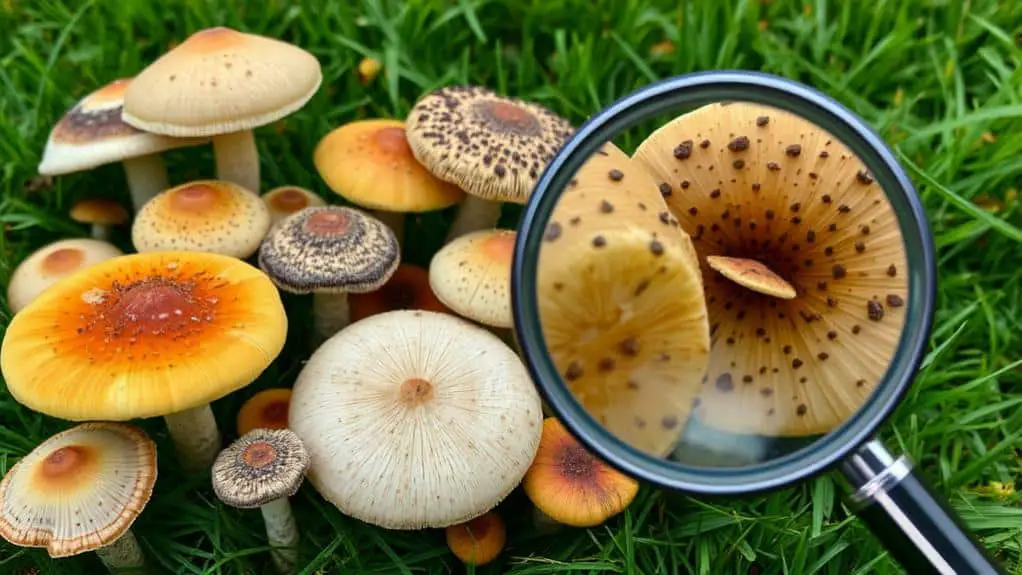
Let's talk about how to identify those mushrooms popping up in your yard!
With over 10,000 species out there, it's essential to know which ones are safe and which could be harmful.
To start, keep an eye out for common types like Field mushrooms and Shaggy manes, but be extra cautious of the toxic Death cap mushrooms.
Common Yard Mushrooms
In your yard, you'll often encounter a variety of mushrooms, each with its own unique characteristics. These lawn visitors appear when conditions are right, usually in moist and shady areas with plenty of organic matter.
Mushrooms in your yard can include Field Mushrooms, which are edible, and Fairy Rings, which form circular patterns indicating mycelium below breaking down nutrients available in the soil.
Shaggy Mane Mushrooms are tall and shaggy and edible when young. Puffballs are round and can be eaten if young but must be identified correctly.
Identification of mushrooms is essential since over 10,000 species exist, some toxic. Always consult a field guide or expert to correctly identify mushrooms in your yard before considering consumption.
Toxic Mushroom Identification
Identifying the mushrooms in your yard becomes even more important when considering the presence of toxic varieties.
Toxic mushrooms, like the Death Cap and Destroying Angel, can be deadly if ingested, so proper identification is essential.
To help you identify these dangerous fungi, look for:
- Death Cap: Greenish cap and white gills.
- Destroying Angel: All white with tall, slender stems.
- Yellow Stainer: Yellow staining on the stem when bruised.
Even non-toxic varieties can look very similar to these toxic ones, so always be cautious.
Use a field guide or consult a local expert if you're unsure.
Proper identification can keep your yard safe and guarantee you avoid any dangerous mishaps.
Benefits of Yard Mushrooms
Seeing mushrooms pop up in your yard might initially seem like a nuisance, but they actually bring several benefits to your garden. Mushrooms indicate healthy soil, rich in organic matter and nutrients. They decompose organic materials, enhancing soil fertility and promoting nutrient cycling. This benefits your lawn by improving soil health.
Mushrooms also boost biodiversity, supporting various organisms and creating a balanced ecosystem. The mycelium, the underground network of fungi, improves soil structure by enhancing aeration and moisture retention. This helps grass and plants grow better. Plus, mushrooms can serve as natural indicators of soil health, alerting you to potential issues that may need attention for ideal lawn care.
| Benefits | Description | Impact |
|---|---|---|
| Soil Health | Rich in organic matter | Enhanced fertility |
| Nutrient Cycling | Decompose organic materials | Improved nutrient flow |
| Biodiversity | Support various organisms | Balanced ecosystem |
| Mycelium | Enhances aeration and retention | Better plant growth |
Manual Removal Techniques
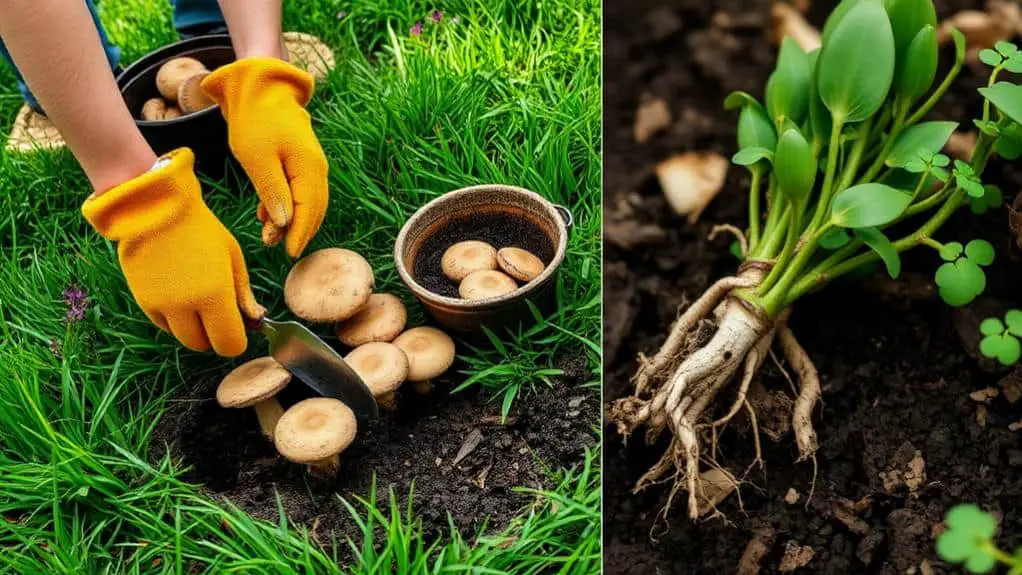
One effective way to remove mushrooms from your yard is by using a spade to dig them out completely.
Here's what you'll need to do:
- Wear gloves to protect your skin and avoid spreading spores.
- Use a spade to dig at least 12 inches deep, ensuring you get all the underground fungi.
- Place mushrooms in a sealed plastic bag to prevent spore dispersal and dispose of it properly.
For persistent mushrooms, applying a mixture of dish detergent and water to the affected area can change the soil conditions and deter future growth.
Remember, manual removal is effective but requires persistence and proper techniques.
Keep at it, and your yard will be mushroom-free!
Improving Lawn Drainage
Often, improving lawn drainage is essential for tackling the root cause of mushroom growth in your yard. By reducing excess moisture, you can create a less inviting environment for fungi.
Start with aeration, which involves poking holes in the soil to help air circulate and water drain better. This reduces compacted soil where moisture can get trapped.
Installing French drains is another effective method to redirect excess water away from problem areas.
Don't forget to regularly clear organic debris like leaves and grass clippings, as these can retain moisture.
Finally, maintain your grass at the right height to encourage healthy growth and reduce shaded, damp spots.
Using Natural Fungicides
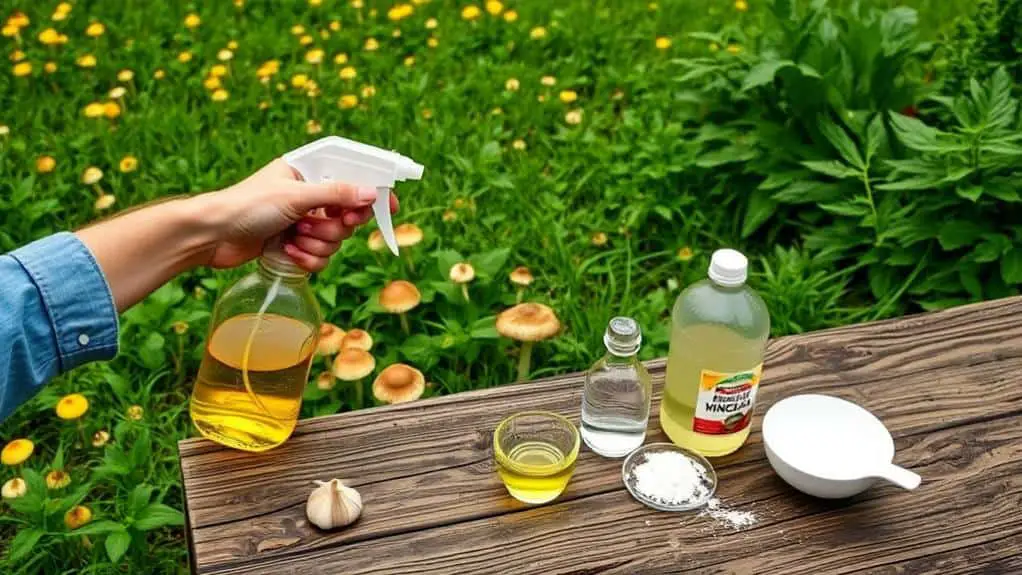
After improving lawn drainage, another effective approach to managing mushroom growth is using natural fungicides. These methods are easy and safe to use.
Here are three natural fungicides you can try:
- Diluted Vinegar: Mix one part vinegar with four parts water and spray directly on the mushrooms. This will kill mushrooms quickly, but be careful to avoid your plants.
- Baking Soda Solution: Combine one tablespoon of baking soda with a quart of water. Spray this on the areas where mushrooms are growing to raise the soil pH and make it less friendly to fungi.
- Dish Soap Mixture: Add a few drops of dish soap to a spray bottle filled with water. This solution can disrupt mushroom growth by altering the soil's pH.
Remember to wear gloves and a mask for protection!
Enhancing Sunlight Exposure
Increasing sunlight exposure is a straightforward and effective method to curb mushroom growth in your yard. By trimming overhanging branches and foliage, you can considerably increase sunlight penetration. This helps dry out damp areas, addressing the excess moisture that mushrooms love.
A sunlit lawn all year round promotes healthy grass growth, which competes with mushrooms for nutrients and space.
Regularly evaluating and adjusting your landscaping can maintain ideal sunlight levels, further minimizing conditions that keep mushrooms thriving. Plus, enhanced sunlight exposure boosts the health of the soil ecosystem, encouraging beneficial microorganisms to outcompete fungi.
With a well-lit lawn, you're not only tackling mushroom problems but also ensuring your yard looks vibrant and healthy.
Regular Lawn Maintenance
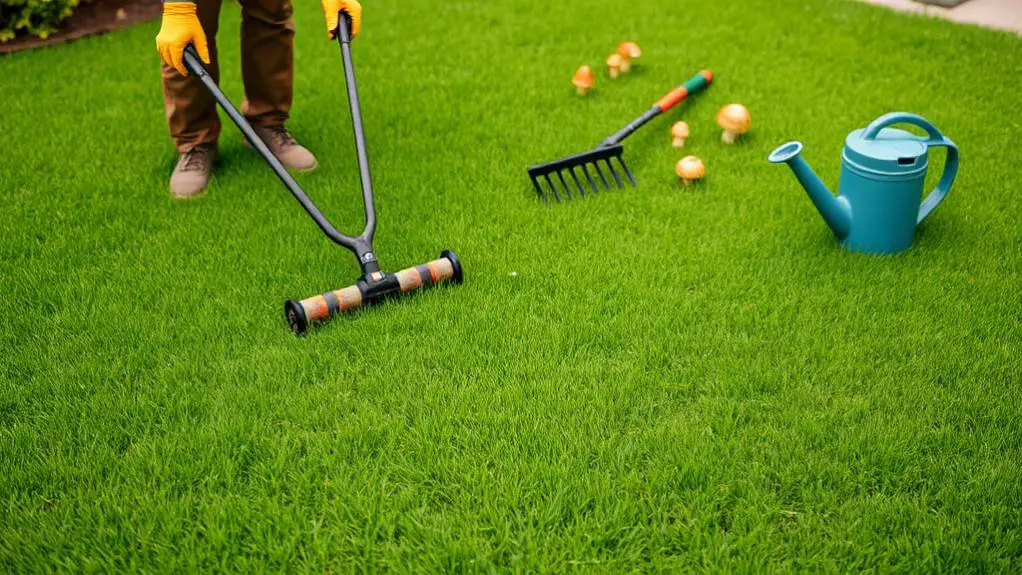
While enhancing sunlight exposure plays a key role in managing mushroom growth, maintaining your lawn with regular care can make a significant difference as well.
Regular lawn maintenance helps promote healthy grass growth, which can outcompete mushrooms for resources. Here's what I do:
- Balanced Fertilization Schedule: I guarantee my grass gets the nutrients it needs without overfeeding, which helps avoid nutrient imbalances.
- Aerating the Lawn: By aerating the lawn, I enhance soil drainage and air circulation, reducing moisture levels that mushrooms love.
- Removing Organic Debris: Regularly clearing leaves and grass clippings minimizes food sources for fungi.
Also, conducting periodic soil testing can identify nutrient imbalances and inform necessary adjustments in my lawn care practices.
Professional Lawn Care Solutions
If you're finding it tough to keep mushrooms out of your yard, professional lawn care services might be the answer.
They offer year-round maintenance programs that tackle soil health and drainage issues, making it harder for mushrooms to grow.
Plus, these experts can identify and fix problems before they get out of hand, keeping your lawn looking its best.
Year-Round Lawn Maintenance
Year-round lawn maintenance with professional lawn care solutions offers a strategic approach to keeping your yard healthy and mushroom-free.
Regular care is essential year round for healthy grass. Professional lawn care experts provide strategic visits to monitor and manage lawn health. They'll remove organic debris and thatch, helping to reduce fungal growth.
Plus, they can aerate your lawn, improving soil drainage and oxygen flow, which mushrooms dislike.
Here's what they typically do:
- Remove organic debris to eliminate mushroom food sources.
- Aerate your lawn to maintain proper soil balance.
- Adjust irrigation to prevent overwatering.
These steps, combined with treating soil imbalances, keep your yard thriving.
Professional lawn care guarantees a lush, mushroom-free lawn all year long!
Expert Drainage Management
Effective drainage management is a cornerstone of professional lawn care solutions, tackling excess moisture that fosters mushroom growth.
By evaluating soil composition and drainage patterns, experts can pinpoint problem areas. Installing French drains is a common method to divert water away, reducing standing water.
Regular soil testing helps identify imbalances and issues, allowing for targeted remedies. Aeration services also play an essential role, enhancing soil aeration and improving water absorption.
Ongoing maintenance programs guarantee these practices are consistently applied, keeping your yard healthy and mushroom-free.
With expert drainage management, you can say goodbye to those pesky fungi and enjoy a lush, vibrant lawn.
Frequently Asked Questions
How Do I Permanently Get Rid of Mushrooms in My Yard?
To tackle mushroom removal, I focus on soil moisture management and use natural deterrents like vinegar. By following lawn health tips and consistent yard maintenance practices, I prevent fungi growth. Organic solutions and sunlight help maintain a healthy yard.
Why Is My Yard Infested With Mushrooms?
Your yard's mushroom growth causes include high soil moisture levels, organic matter presence, poor lawn drainage, and extended shade. These conditions create the perfect environment for the fungal lifecycle stages, indicating a need for better yard maintenance practices.
Will Vinegar Kill Mushrooms in the Yard?
Yes, vinegar's effectiveness depends on mushroom types and yard conditions. Apply diluted vinegar directly, but be mindful of safety concerns. Alternative methods and proper application techniques are essential for long-term solutions since vinegar won't eliminate the mycelium.
Does Baking Soda Kill Mushrooms in the Lawn?
Yes, baking soda's effectiveness can vary based on mushroom types and soil acidity. I've found it helps with moisture control, but you should monitor lawn health. Combining it with other natural remedies and preventive measures is best.
Conclusion
Getting rid of mushrooms in your yard might seem tricky, but with the right steps, it's totally doable! Start by removing decaying matter and aerating your lawn. Put on gloves when pulling out mushrooms and seal them in plastic bags. Use natural fungicides like vinegar, and don't forget to trim overhanging branches to let in more sunlight. Regular maintenance is key, and if things get tough, don't hesitate to call in a professional. You've got this!

